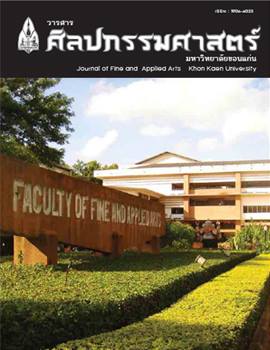การศึกษาลักษณะและรูปแบบจิตรกรรมฝาผนังอีสานกับการพัฒนาจิตรกรรมไทยร่วมสมัยอีสาน
Main Article Content
Abstract
This research aimed to study characteristics and pattern forms of E-Saan paintings and to relate them to the current development of contemporary Thai E-saan paintings. The participants were 7 contemporary Thai E-Saan painting artists, 10 monks (heads of monastery), 4 current E-Saan mural painters, and 9 community leaders. The research tools were the interview illustrations, the interview forms, the audio recording, and the photograph taking. The data were analized by using the descriptive method and photographs.
The results revealed that
1. In terms of contents, the E-Saan mural paintings vividly featured Buddhism and community life styles. The contemporary Thai E-Saan painting artists applied these contents to create their work properly. To do so, it was suggested that the artists and painters seek advice from the expertise in Buddhism.
2. In terms of work creation, the natural materials available at that time were limitedly used to create E-Saan mural paintings. It was a kind of Primitive Art which was simple in the society at the time. In contrast, the contemporary Thai E-Saan paintings were created on such academic principles as Composition, Anatomy, and Perspective, etc. This made their work interesting, and remained featuring the contemporary Thai E-Saan paintings which related to the same contents but used the materials available at present together with the artist’s skills. The outcomes were contemporary and harmonious with the current society.
3. In terms of aesthetics, the E-Saan mural paintings are valuable and perfect in themselves. They are unchangeable, and exist beyond time and place. The work was based on Objectivism and Relativism. To judge its aesthetics, the culture of that work had to be taken into account. As for the contemporary Thai E-Saan paintings, the value judgment depends on the audience’s experience which varies. It is Subjectivism.
4. Problems and suggestions for artists to create their work were that the artists themselves should outline their work. Other people had different tastes which might affect the creation of work. Also, the artists should work in their own studio, and eventually bring their work to install at the temple properly.Article Details
Content and information in articles published in the Journal of Fine and Applied Arts of Khon Kaen University is regarded as the opinion and sole responsibility of the author(s) directly; therefore, editors are not obliged to agree to or share any responsibility with regard to the content and information that appears within these articles.
All articles, information, content, image, etc. that have been published in the Journal of Fine and Applied Arts of Khon Kaen University is the copyright of the Journal of Fine and Appllied Arts of Khon Kaen University. Any person or organization who wishes to distribute all or parts of the articles for further dissemination or other usage must first receive permission from the Journal of Fine and Applied Arts of Khon Kaen University before proceeding to do so.


